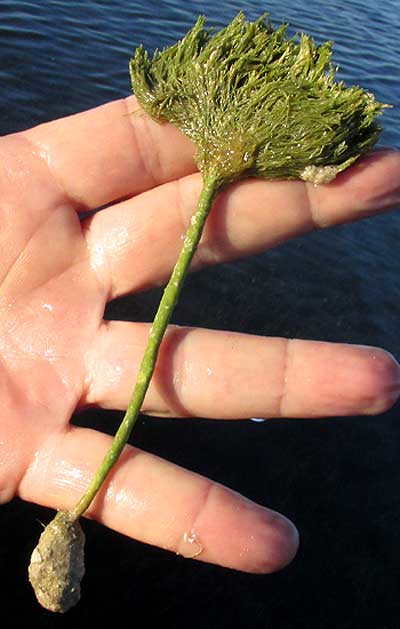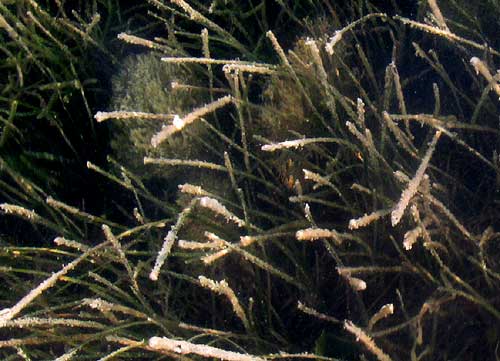Excerpts from Jim Conrad's
Naturalist Newsletter
from the February 15, 2015 Newsletter issued from Río Lagartos, on the Yucatan Peninsula's northern coast (~N21.60°, ~W88.16°), Yucatán state, MÉXICO
SHAVING BRUSH ALGA
When the tide is very low, as during our recent full-moon days, sometimes on flamingo-viewing trips you can reach over the boat's edge and pick interesting aquatic organisms off the estuary's floor. That's how I collected what's shown below:

This interesting being has been shaken briskly in the water to knock off the pale marl and general gunk that collects on sedentary things in the estuary's waters. From the boat when it was covered with marl, it looked more like an aquatic fuzz-ball lodged in an ocean of Shoalgrass blades, as shown below:

In my hand the thing felt a little stiff and crunchy, as often is the case with aquatics that become encrusted with calcium carbonate in carbonate-rich waters such as ours, or incorporate it into their bodies.
If last week I hadn't profiled the Mermaid's Fan, a member of the green alga family Udoteaceae, I wouldn't have had an idea of where to start trying the identification process. However, this week's discovery shares several features with the Mermaid's Fan and in fact belongs to the same family. By doing an image search on Google, on the keyword "Udoteaceae," and looking for algae with the general appearance of our find, it was easy to figure out that our alga is member of the genus Penicillus.
Four Penicillus species are listed for the Yucatan's waters, of which only one is described as inhabiting lagoons such as Ría Lagartos Estuary -- the others being marine. And that one lagoon-loving species is also the one looking most like ours, with its egg-shaped bushiness atop a long, slender stem. Our alga is called the Shaving Brush Alga, PENICILLUS CAPITATUS, and it's described as among the most common and conspicuous shallow water macroalgae in the Caribbean region.
Shaving Brush Alga is "coenocytic," which means that instead of being composed of cells with walls, the organism's many nuclei, photosynthesizing chloroplasts and other organelles remain loose within its body's cytoplasm. In fact, the whole body may be considered one gigantic cell. This is a characteristic condition of the whole green alga order known as the Bryopsidales, to which Shaving Brush Alga belongs, so it's not just peculiar to this one species.
Shaving Brush Alga mostly reproduces vegetatively, through fragmentation, but under special conditions the contents of the whole organism transform into untold numbers of sexual gametes, which are released into the water, have sex, and produce new Shaving Brush Algae. This mode of sexual reproduction is known as "holocarpy." A study in the waters of St. Croix found that Shaving Brush Algae lived from between one and 16 weeks, with most individuals surviving eight weeks or longer.
Shaving Brush Alga grows in shallow, warm bays and lagoons, where it may form large colonies or be mixed with sea grasses, as in our case. It's distributed from southern Florida and the Bahamas through the Caribbean.